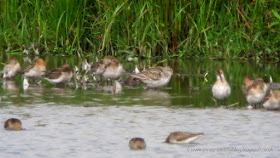So, here's my post looking back on what was a great year of Patchwork Challenge at my Druridge Bay North patch...
The good birds started straight away on our first visit on the 2nd of January. Sightings that day included the flock of 7
Shore Larks at Chevington burn mouth,
Bittern,
Hen Harrier and
Glaucous Gull. Not a bad start! On the 21st we were at Chevington for first light to see by far the rarest bird of the year - the juvenile
Pacific Diver...
Eurasian White-fronted Geese were very easy to see on the patch during January and our peak count was 33 flying over Druridge Pools on the morning of the 29th.
On the 18th of March the first
Sand Martins returned, while
Scaup were around in good numbers. A
Snow Bunting and
Slavonian Grebe were at Chevington. A week later an extremely smart drake
Ring-necked Duck turned up on the north pool there.
The following day (26th) Druridge Pools played host to the first
Great White Egret of the year as well as a great count of 5
Water Pipits.
Thankfully we didn't miss anything on our holiday to Mallorca, but on our return a
Hooded Crow was at Druridge Pools. On the 21st a summer plumage
Black Tern arrived at Chevington. A
Green-winged Teal was at Druridge Pools for the last week of April.
In early May a
Channel Wagtail and
Jack Snipe showed well at Druridge...
A first-summer
Little Gull also performed well there on the the 20th, a species which was surprisingly scarce throughout the year.
The 20th also produced a female
Blue-headed Wagtail...
Spoonbills featured quite a lot during the summer following on from our first sighting on 27th...
Wader passage through the summer was also good with a
Pectoral Sandpiper, at least 7
Wood Sandpipers (on the same day) and a
Spotted Redshank being highlights. On the 1st of July a
Red Kite came in off the sea and a stunning adult
White-winged Black Tern was at Druridge.
On the 11th of August an adult
White-rumped Sandpiper relocated to Druridge Pools after being at Cresswell for a few days...
Overnight ringing on the 12th produced a couple of
Storm Petrels. The 21st produced the next good bird with an attractive
Spotted Crake,
also at Druridge Pools...
On the 30th of August I found a pair of juvenile
Pectoral Sandpipers there...
A
Red-necked Grebe was just offshore a couple of days later. One of the highlights of the year came on the 24th when we very unexpectedly flushed a
Quail twice from the dunes at Hadston. This was a lifer for both of us after so many fruitless attempts for them in the past.
Other autumn birds included a
Black-necked Grebe at Chevington and 2
Whinchats at Druridge. On the 7th of October one elder bush there held three species of
sylvia: a
Blackcap,
Garden Warbler and a
Barred Warbler.
Three days later a smart juvenile
Red-necked Phalarope turned up at Druridge Pools...
The best moment of the year came when we found a couple of
Bee-eaters flying low over Chevington. What was almost certainly one of the same birds lingered at Druridge Pools the following week.
A
Shore Lark returned to Chevington on the 27th and was joined by two
Snow Buntings. This was our last notable sighting of the year.
The scores:
Total species: 186
Total points: 280
Finally, here's a condensed list of the best birds...
8 Shore Larks
Hen Harrier
Pacific Diver
Ring-necked Duck
3 Great White Egrets
5 Water Pipits
Green-winged Teal
Blue-headed Wagtail
4 Spoonbills
Red Kite
White-winged Black Tern
3 Pectoral Sandpipers
White-rumped Sandpiper
Spotted Crake
Quail
Barred Warbler
Red-necked Phalarope
2 Bee-eaters
What a year!




























